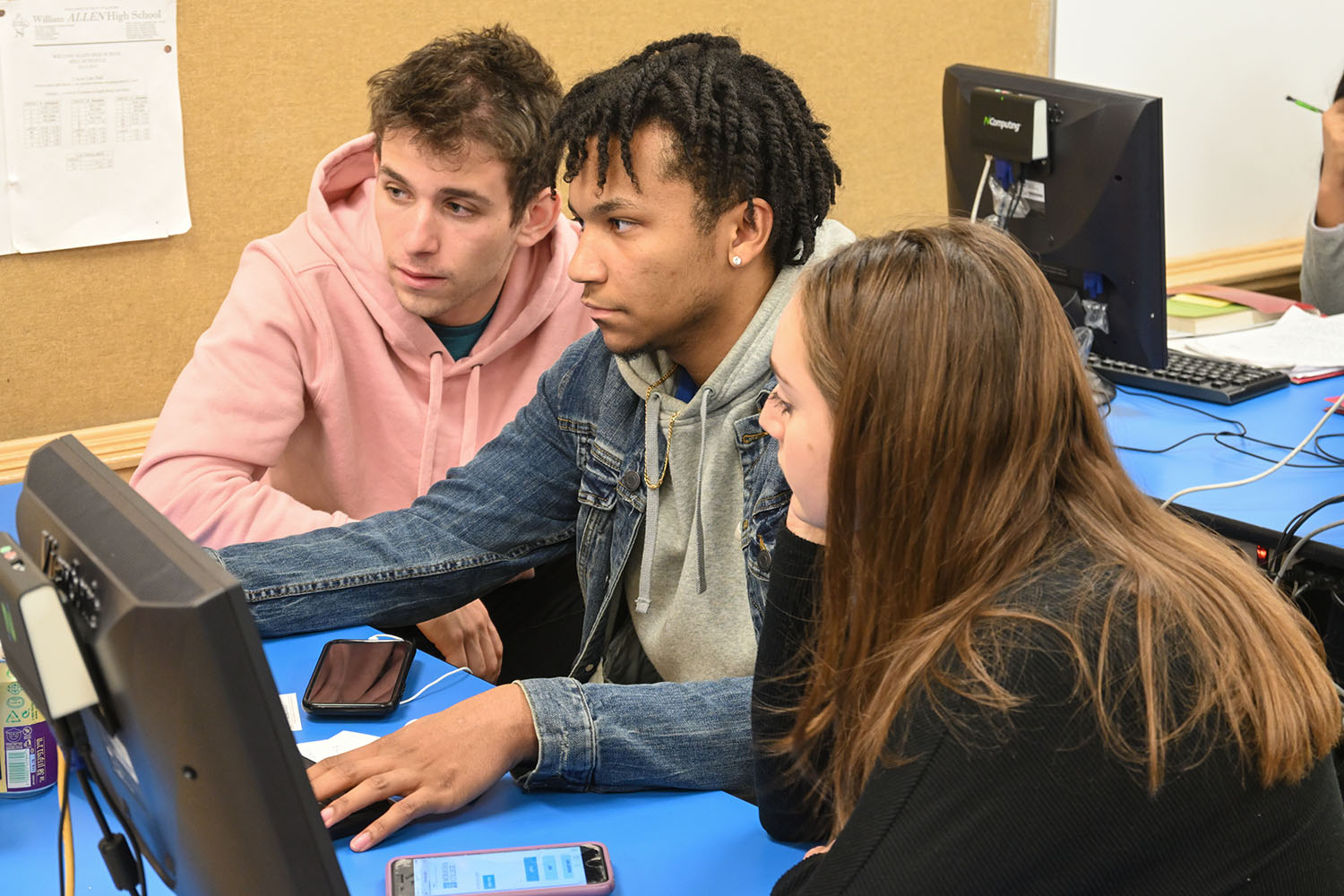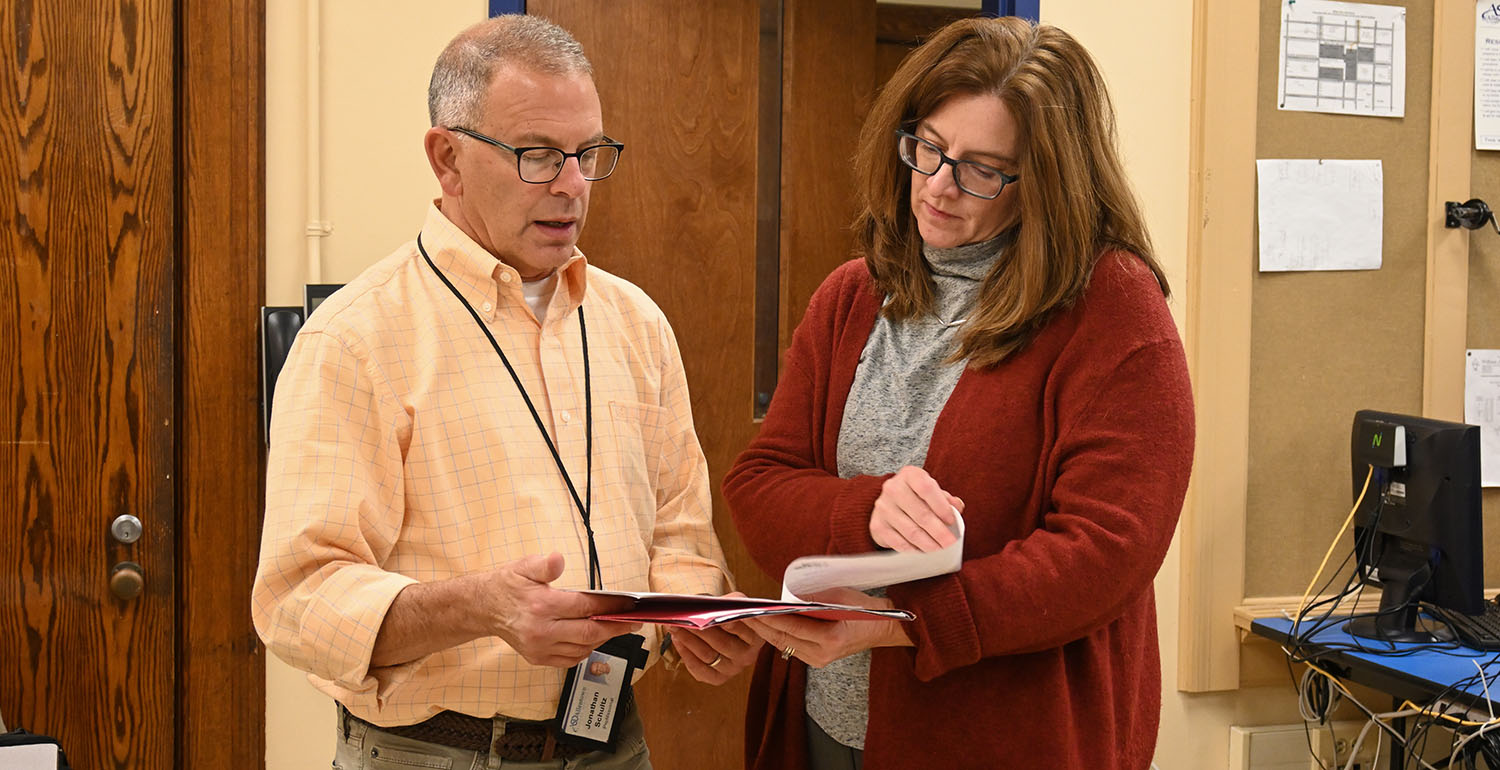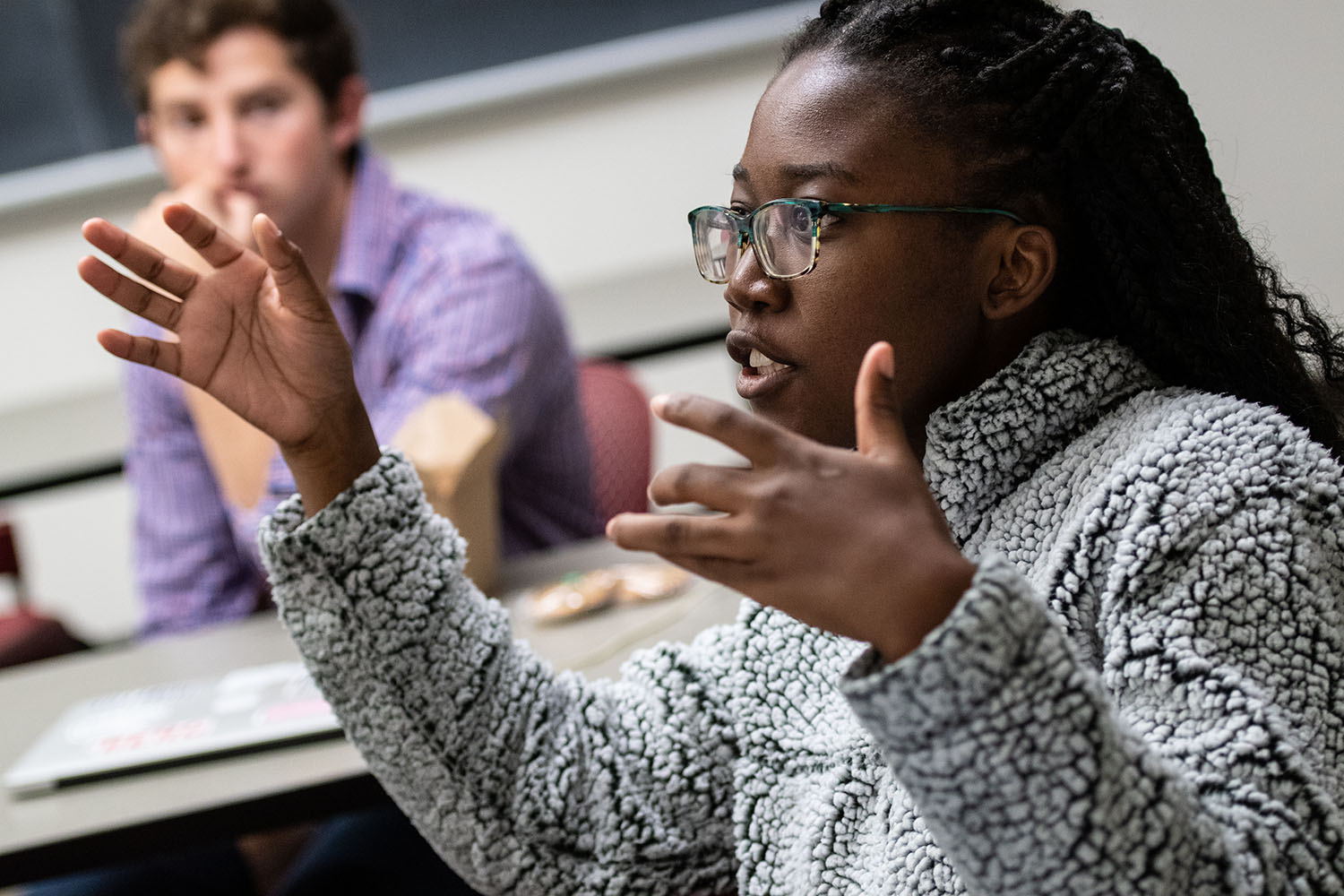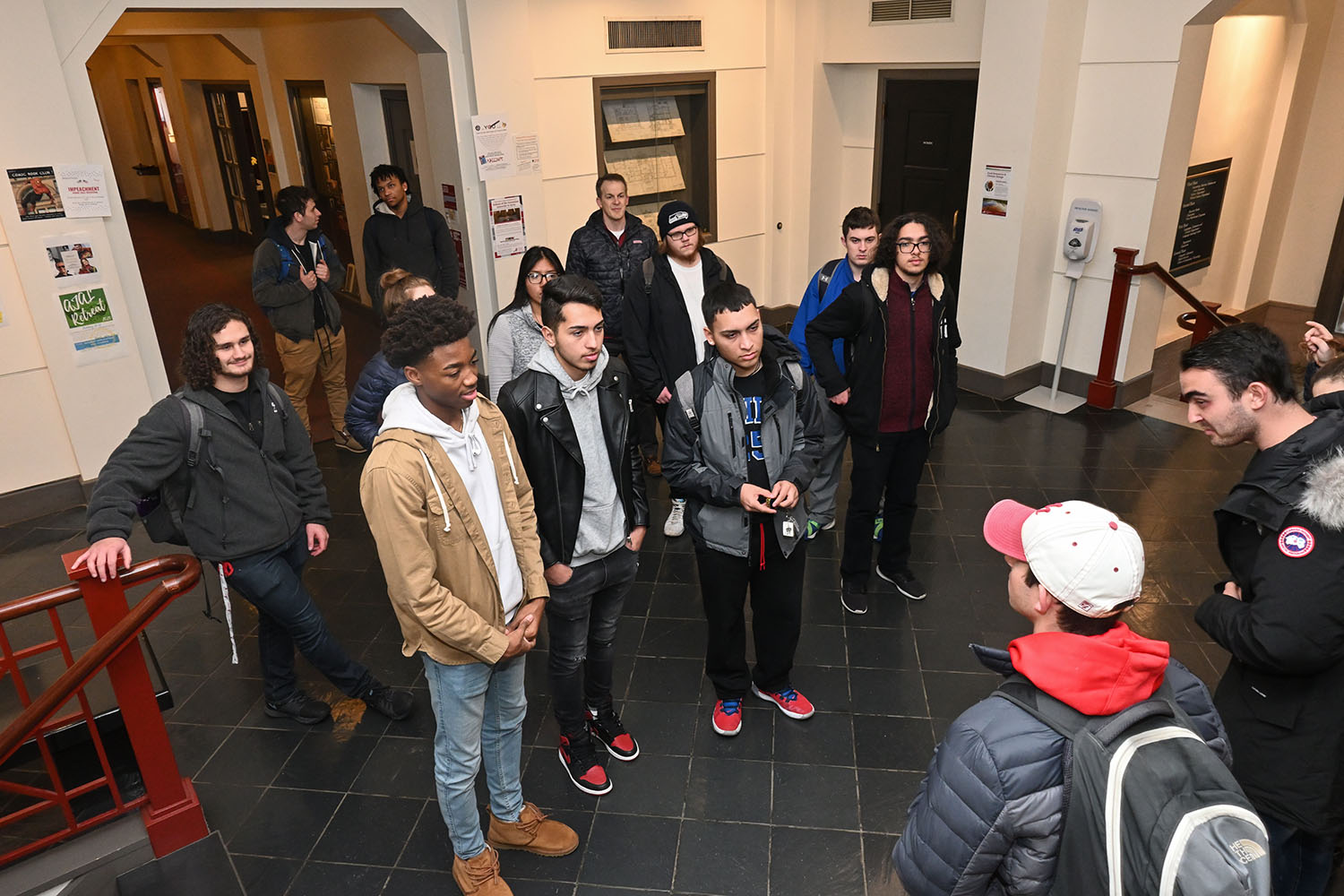A Powerful Partnership
Muhlenberg’s College Admissions Mentoring Program finds its stride as part of an integrative learning course, Politics, Policy and the Opportunity Gap.
By Meghan Kita | Photos by Tom Amico
On a Wednesday afternoon in October at Allentown’s William Allen High School, seniors trickle into a third-floor computer lab. They’re here for Muhlenberg’s College Admissions Mentoring Program (CAMP), and their 15 Mule mentors sit waiting for them. For the next 50 minutes, the Allen-Muhlenberg student pairs will work on admissions essays, or the Common App, or one of the many forms required to get into college or to secure the financial aid necessary to attend.
Michele Deegan, interim dean of academic life and co-founder of CAMP, passes out clementines and other snacks. Jonathan Schultz, a history teacher who’s been with the Allentown School District for 35 years, pops in and out of the classroom as he works to track down a couple missing Allen students.
When the period ends, the last of the day, the group lingers—the Allen students wrapping up their work, the Muhlenberg students devising a plan for what needs to be done before next week’s session. Chatter, some college-related, some not, fills the room.
The Muhlenberg students are here as part of Deegan’s Politics, Policy and the Opportunity Gap class. For the first time since its inception in 2016, CAMP is not a volunteer opportunity but a component of an integrative learning course. In the classroom, Deegan’s students learn about why school districts and communities like Allentown are under-resourced and how that affects under-resourced students. At Allen, each of Deegan’s students is partnering with a high school senior to assist them with the college application process.
The Allen students are here because Schultz or one of his colleagues invited them. “What we’re looking for are kids who, without this program, might slip through the holes,” he says, “kids who are motivated academically, show commitment and are willing to work hard through a process.”
One of those students is Elian Sosa. Sosa, who was born and raised in the Dominican Republic, has been in the Lehigh Valley for about two years. He came to the United States with his mother after she married a man from Allentown, and he found himself starting his junior year at Allen. While he had received a few years of English instruction in the Dominican Republic, it was his first time facing full days of classes held in English. “It was scary,” he says. “It was really hard.”
When Sosa and his Muhlenberg mentor, Jake Whittingslow ’20, were working on college essays, Sosa shared the story of how he came to Allentown. “[Jake] told me that I can write about that,” Sosa says, “kind of compare the two lives I’ve had, in Dominican Republic and the one I’m living here. I think it’s going to turn out pretty well.”
 Solomon Bergwerk '21 works with his Allen student partner, Isaiah Vigo.
Solomon Bergwerk '21 works with his Allen student partner, Isaiah Vigo.
Understanding the Allentown School District
Sosa’s circumstances might stand out to a college admissions officer, but they’re not terribly out of the ordinary at Allen: A little more than 23 percent of the high school’s 2,605 students are English Language Learners. Demographically, the student body is predominantly Hispanic (73 percent), with far fewer students identifying as black (16.2 percent), white (8.6 percent) or Asian (1.5 percent). A majority of Allen students live in poverty, with 64.5 percent of the student body considered economically disadvantaged. And the Allentown School District itself is financially strapped; it took out a $10 million loan this spring to cover salaries and other expenses.
One reason Allen has struggled is because Pennsylvania, like many states, relies heavily on property-based taxes to fund its public schools, something Deegan explains in her class. According to the most recent U.S. Census data, the average property value in the Allentown School District is about $124,000; in neighboring South Whitehall Township (part of Parkland School District), it’s $232,100. So, even though Allentown’s school tax rates are higher (roughly 2 percent versus 1.6 percent in Parkland), the amount of revenue generated per student is far lower. To get a sense of the disparity, the average home in Allentown generates $2,489.21 in school taxes. The average home in South Whitehall? $3,669.50.
Schultz, an Allen graduate himself, has firsthand insight into how dwindling funds hurt students. Take, for example, the high school’s start time of 7:15 a.m. One reason for the early start is financial: The district doesn’t bus the majority of its students, but it’s required to provide transportation for students with special needs. To save money by repurposing the same buses for students in elementary, middle and high school, district administrators decided in 2013 to have the high schoolers start the day earlier. (Schultz says the start time was 8:25 a.m. for most of his time teaching at Allen.)
Now, “our first and second period failure rates are off the charts,” Schultz says. “If kids whose parents work have siblings in elementary and middle school, they have to make sure their younger siblings get to school before they can come in. Some of these kids are walking from Center City, a 40-minute walk. It takes a hard situation and makes it worse.”
Adding to the district’s woes is the proliferation of charter schools, which receive taxpayer funding for each student they enroll without an elected school board or other public oversight in place. There are currently 13 public charter schools within 10 miles of Center City Allentown, with another 14 statewide cyber-charters available for virtual enrollment. The Allentown School District sends $60 million in tuition to charter schools, up from $15 million seven years ago.
 Jonathan Schultz and Michele Deegan have a discussion before a CAMP session at Allen.
Jonathan Schultz and Michele Deegan have a discussion before a CAMP session at Allen.
How CAMP Has Evolved
The school district’s circumstances relate to Deegan’s scholarly interests, in the connection between economic and political inequality. And, when Deegan helped launch CAMP in the spring of 2016, she’d just helped guide one of her own children through the complex college admissions process. She partnered with colleagues at Cedar Crest College and DeSales University for those first iterations, when CAMP was a volunteer opportunity not tied to a course. The idea was to encourage high school juniors to start thinking about college and careers in the spring and to help them apply to colleges as seniors in the fall.
CAMP has evolved over the years: Deegan’s colleagues pulled out due to teaching obligations, and, in turn, the program’s scope has narrowed to the fall application process. But, Val Weisler ’20 stepped in as CAMP’s program coordinator, a role that includes designing and teaching the curriculum to Muhlenberg mentors, serving as a soundboard for any questions from mentors at CAMP and organizing a day of college tours. (Through her nonprofit organization, The Validation Project, Weisler also provided funding for college-tour transportation and the snacks available at Allen each week.) And, for the first time this fall, CAMP is held during Allen’s eighth period instead of after school, which has bolstered Allen students’ ability to attend regularly—it no longer conflicts with extracurriculars or after-school jobs.
The biggest difference, of course, is that CAMP now exists as the community-engaged learning component of an integrative learning course. The Muhlenberg students involved are more committed than ever—attending each week is part of their grade—and their coursework prepares them to better understand what’s happening at Allen.
“The classroom experience discusses the causes and consequences of the opportunity gap, which is created when families and communities are under-resourced and face difficulties pulling themselves out of poverty due to economic and political forces that benefit wealthier areas,” Deegan says. “In class, we discuss these challenges and their interconnectedness and how public policies affect opportunities for under-resourced individuals, for better and worse.”
Because of this classroom work, she says, students are better attuned to the school environment and the students at Allen, who share their stories about daily life as they work on the college admissions process. After every session at Allen, the Muhlenberg students complete a reflection essay, which asks them to make a connection between their readings and their community-engaged learning experience.
“I ask them to reflect upon how this integrated experience is changing them and their perspective,” Deegan says. “For many, this class experience has been a game-changer, as they are much more aware of their privilege and how important it is to engage in the simple act of listening and being supportive.”
Deegan’s students quickly identified the need for another major change to CAMP: to visit Allen weekly instead of every other week. Solomon Bergwerk ’21, an international studies major and innovation & entrepreneurship minor, says he led that charge.
“Everyone said it was a great idea. Why wouldn’t we give it 100 percent?” he says. “And every kid from Allen said they would show up every week.”
To make that happen while still fulfilling Muhlenberg’s academic requirements, Deegan had to tack on time to Monday’s classroom sessions—and her students were on board. Craig Smith, Allen’s counseling department chair, says that, of all the college readiness programs available at the school, CAMP is the only one that offers weekly, one-on-one attention during the school year.
 Grace Duah '20 participates in a class session at Muhlenberg. (Photo by Ryan Hulvat)
Grace Duah '20 participates in a class session at Muhlenberg. (Photo by Ryan Hulvat)
Results and Goals
Consistent, weekly meetings helped Bridget Cantor ’20, a sociology major, forge a bond with her mentee, Mayson Kratzer. Their first meetings were awkward—they’re both quiet—but then Cantor drew on her own experience: She attended an under-resourced small public high school in Brooklyn, one that happened to have a top-notch college counselor who hired a team of interns to work under him. Cantor, a first-generation college student, relied heavily on this support when applying to colleges.
“I thought of the intern who worked with me. She had a game plan every time,” Cantor says. So she made a list of what needed to be done and when, and she came to each session with worksheets and questions and goals to work toward. She shared the personal stories she used in her college essays to inspire Kratzer to share and reflect on his own experiences.
“The dialogue we have in the classroom is always so great,” Cantor says. “But the relationship I’ve built with Mayson, the tremendous impact this can have on someone, can make a huge difference. I didn’t think I’d feel this way. I’m doing it more for Mayson than for myself. I’m doing this because I was so fortunate to have that opportunity to work with someone.”
By mid-November, all 15 CAMPers had been accepted to Lehigh Carbon Community College, with two accepted early-decision to four-year schools (Kutztown University and East Stroudsburg University). To help put those numbers into context, 37 percent of Allen’s 2019 graduates went on to two-year colleges and 14 percent to four-year colleges.
It’s too soon to know where this year’s CAMPers will actually end up next fall, but there’s more to this story than the numbers, says Schultz: “What the Muhlenberg students are putting in and how much effect they’re having on these kids is impossible to measure. If half these kids end up going to college and half those kids end up graduating, that’s four or five kids that never would have had a shot at it without this program. It’s potentially life-changing for these kids.”
In an ideal future, Deegan says, there would be a consistent way to offer CAMP-like support earlier in an Allen student’s career. One potential way forward would be for one of the co-founders of CAMP to re-engage and to offer a spring course like Deegan’s, so the work counts toward their teaching load. In spring, the work at Allen could focus entirely on career exploration, a topic that gets short shrift in the fall, when college application deadlines loom. This is in the works for 2021.
Pairing CAMP with coursework doesn’t just benefit overburdened professors—the college students get far more out of the experience in this format, Deegan says. “Students have a better sense of the challenges of their community. It’s helped them have such a deeper understanding of what the students at Allen are up against. It requires them to reflect more on themselves and their identities in a way that has been transformative to our students. I’ve been blown away by their own personal growth and their self-confidence.”
 Allen students and their Muhlenberg partners visit Ettinger during a College tour.
Allen students and their Muhlenberg partners visit Ettinger during a College tour.
